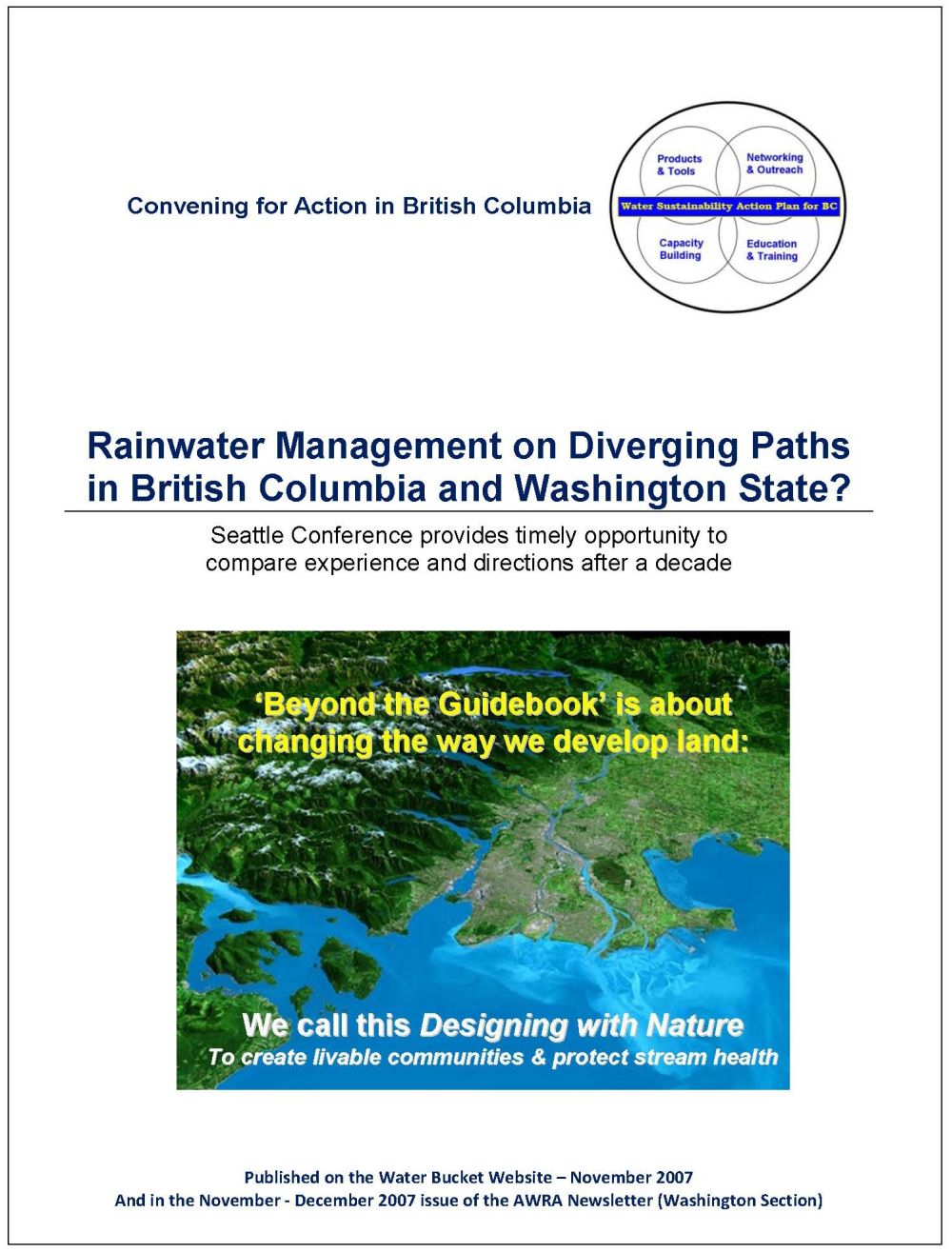ARTICLE: Rainwater Management on Diverging Paths in British Columbia and Washington State?
Note to Reader:
In October 2007, the American Water Resources Association (AWRA) and the Canadian Water Resources Association (CWRA) co-hosted a conference in Seattle that included a cross-border panel session on Stormwater Management and Low Impact Development. The panel session created a timely opportunity to compare an American top-down prescriptive approach versus a Canadian bottom-up educational approach.

Kim Stephens (Water Sustainability Action Plan) and Remi Dubé (City of Surrey) provided a British Columbia perspective, while Ed O’Brien (Department of Ecology) and Dr. Gary Minton (independent practitioner) provided a Washington State perspective.
An article about the panel session was then published in the December 2007 issue of the AWRA Newsletter (Washington Section). To download a copy, click on Rainwater Management on Diverging Paths in British Columbia and Washington State?

Contrasting British Columbian and Washington State Approaches
The integration of rainwater management and land use is the differentiator between British Columbia and Washington State.
“In Washington State, we cannot achieve environmental protection using current methods of development,” bemoaned Ed O’Brien, “Not many new developments are applying low impact development techniques. There isn’t a land use dictator who can demand change. It will take public education to instill a culture change for us to have any hope that we can protect aquatic resources in the urban environment.”
According to Kim Stephens: “In British Columbia, we are creating change through on-the-ground partnerships. For us, designing with nature has become a rallying cry.”

Designing with Nature in BC
“In British Columbia, we have made a conscious decision to go the educational route,” reported Kim Stephens, “It is all about establishing expectations and creating an environment that encourages innovation and gets practitioners excited about what they are doing. The culture is changing.”
“We call our approach designing with nature,” continued Remi Dubé, “We have borrowed from the teachings of Ian McHarg because we believe this is the way we will create livable communities and protect stream health.”

What is Holding Washington State Back?
Ed O’Brien, in his presentation, stated that: “Locally, our knowledge was and still is way ahead of the federal game because of Puget Sound Plan initiatives and a few forward-thinking local governments. The federal rules impede our progress in implementing strategies and requirements that we know are necessary.”
Kim Stephens agreed. “Rainwater management practice in Washington State is apparently being driven by a water quality regulation when a decade ago the science…and in particular the work of Rich Horner and Chris May…told us that changes in hydrology, not water quality, must be the focus of our efforts. If you get the hydrology right, water quality typically takes care of itself.”
Change the Way Land is Developed
Stephens, Dubé, Minton and O’Brien agreed on the need to tackle land use because that is where changes in hydrology are created. “We have a number of manuals in Washington State, but the design criteria don’t reflect what we have learned,” observed Gary Minton.
Minton and O’Brien both commented on the limited effectiveness of end-of-pipe solutions. “Yet that is where all your effort is going….into ponds at the end of piped conveyance systems,” commented Kim Stephens. “Yes, and the ponds are over-sized,” added Dr. Gary Minton.
 “Considerable progress has been made in the acceptance of Low Impact Development concepts, which is heartening. However, we must not lose sight of the reality that the vast majority of new development will be traditional and that retrofitting will have a modest impact in the near future,” warned Dr. Gary Minton.
“Considerable progress has been made in the acceptance of Low Impact Development concepts, which is heartening. However, we must not lose sight of the reality that the vast majority of new development will be traditional and that retrofitting will have a modest impact in the near future,” warned Dr. Gary Minton.
To Learn More:
To read the complete story, click on Rainwater Management on Diverging Paths in British Columbia and Washington State?


